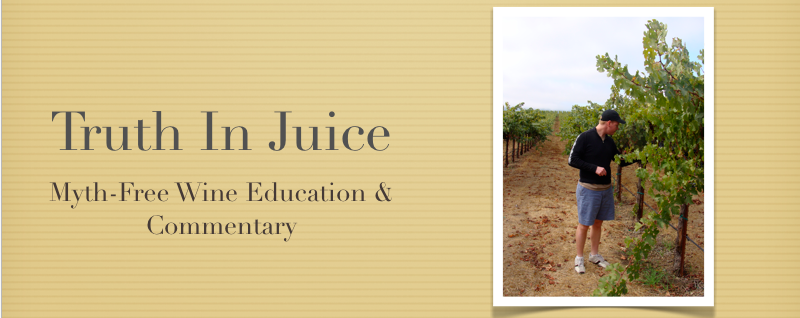Sparkling Wine: Not Only for New Year's
 Sunday, January 6, 2013 at 8:14PM
Sunday, January 6, 2013 at 8:14PM  New Year's Eve is the one evening each year when nearly every wine drinker opts for a bottle of sparkling wine. The pop of the cork, and the effervescent tingling of bubbles on the tongue is an deeply ingrained New Year's tradition, almost like gifts under the tree at Christmas. Sadly, despite this country's affinity for bubbles during the holidays, sparkling wines are largely forgotten during the rest of the year. This does not have to be, nor should it be the case, for sparkling wines are some of the most versatile food wines in existence. A good Champagne can easily bridge the gap between foods that would normally require separate wine pairings, such as steak and lobster. It tames spice nicely, making it a nice match for Asian dishes and sushi. Finally, it is equally well-matched for both light and hearty fare. Champagne's descendents and relatives (Cava, Prosecco, American Sparkling Wines) each have their own virtues as well. Since there is a plethora of sparkling wine articles in circulation this time of year, I'll keep this brief, but I will make the plea that you not constrict your sparkling wine consumption to holiday celebrations. Sparkling wines have so much more to offer.
New Year's Eve is the one evening each year when nearly every wine drinker opts for a bottle of sparkling wine. The pop of the cork, and the effervescent tingling of bubbles on the tongue is an deeply ingrained New Year's tradition, almost like gifts under the tree at Christmas. Sadly, despite this country's affinity for bubbles during the holidays, sparkling wines are largely forgotten during the rest of the year. This does not have to be, nor should it be the case, for sparkling wines are some of the most versatile food wines in existence. A good Champagne can easily bridge the gap between foods that would normally require separate wine pairings, such as steak and lobster. It tames spice nicely, making it a nice match for Asian dishes and sushi. Finally, it is equally well-matched for both light and hearty fare. Champagne's descendents and relatives (Cava, Prosecco, American Sparkling Wines) each have their own virtues as well. Since there is a plethora of sparkling wine articles in circulation this time of year, I'll keep this brief, but I will make the plea that you not constrict your sparkling wine consumption to holiday celebrations. Sparkling wines have so much more to offer.
With that being said, here's a review of a sparkling wine tasting that we hosted in conjunction with Burlington Wine Shop in December, and a brief run down on the different types of sparkling wines that you might encounter throughout the year.
Champagne - Gaston Chiquet Brut Tradition NV
Champagne is the grandfather of sparkling wines, but did you know:
- That Champagne's sparkle was discovered by accident? In its early days, Champagne's vintners strove to compete with the wines of Burgundy, and were continually frustrated when the region's cold winters (Champagne is the most northern wine region in France) resulted in paused fermentations, because the cold weather sent the yeasts into dormancy while there was still residual sugar in the wine. When the dormant yeasts awoke in the spring, the fermentation process restarted, and CO2 given off as part of the fermentation process became trapped in the wine, giving it a fizzy quality. After numerous unsuccessful attempts to combat this supposed flaw, Champagne vintners decided to embrace it, and eventually refined the secondary fermentation process to produce the wine know and love today.
- Dom Perignon did not invent Champagne, but was instrumental in many of the major early refinements in the region.
- Champagne's sparkle is derived from a secondary fermentation that is induced by the winemaker after the Champagne has been bottled. This method of secondary fermentation, known as Méthode Champenois or Méthode Classique is one of the principal characteristics that distinguishes Champagne from other sparkling wines.
- Non-Vintage Champagne (NV) must be aged for a minimum of 15 months in bottle before release, and Vintage Champagnes (where all the grapes used in the Champagne are from the same vintage) must be aged for 3 years in bottle before release.
- Most Champagnes are made from a blend of at least 30 - 60 different still wines.
- Chardonnay, Pinot Noir, and Pinot Meunier are the three principal grapes of Champagne, but the old laws of the region allow for any member of the Pinot family to be used, and small amounts of Arbanne, Petit Meslier, Pinot Blanc and Pinot Gris can be found in Champagne today.
- The small letters RM (Récoltant manipulant) or NM (Négociant manipulant), generally found on the bottom of a Champagne's label inidicate whether the Champagne was estate grown (RM), or whether the grapes were purchased (NM). Grower Champagnes are small-production, artisanally produced Champagnes, such as Pierre Gimonnet, Gaston Chiquet, L. Aubry Fils, among others. Negociant Champagnes are the Champagnes produced by the large Champagne houses with which most of us are familiar - Moët & Chandon, Piper-Heidsieck, Veuve Clicquot, etc.
Prosecco - NV Montesel Vigna del Paradiso Prosecco
Prosecco is one of many sparkling wines found in Italy, but it is the one that most American consumers are most familiar with. Unlike Champagne, it is made in the Charmat method, in which the secondary fermentation used to impart the the wine's sparkling character is conducted in tank, as opposed to the bottle. Other famous Italian sparkling wines include the wines of the Franciacorta region, in Lombardy, the sparkling wines of the producer Ferrari, in Trentino, and Moscato d'Asti in Piedmont. Both Franciacorta and Ferrari's wines are produced in the Méthode Classique style, while most Moscato d'Asti is made using the Charmat method, although some producers still the Méthode Classique.
Prosecco is the second most popular Italian sparkling wine, after Moscato d'Asti. Did you know:
- That Antonio Carpene of the Carpene Malvolti winery invented the Charmat method, which is used in the production of most Prosecco? (Méthode Classique is permitted in the DOCG zone of Prosecco di Conegliano-Valdobbiadene.)
- Prosecco is the name of the grape used to produce Prosecco, but it is also known as Glera.
- In 2009, the DOC zones of Prosecco di Conegliano-Valdobbiadene and Prosecco di Montello e Colli Asolani were upgraded to DOCG status, and the provinces of Belluno, Gorizia, Padova, Pordenone, Treviso, Trieste, Udine, Venezia, and Vicenza, which used to produce IGT Prosecco, were upgraded to DOC status.
- As of 2009, all other regions of Italy producing Prosecco must label it as Glera.
- There is a hill called Cartizze in Valdobbiadene, where ~262 acres of vineyards comprise what is regarded as the "Grand Cru" of the Prosecco DOCG zones. This area has been given its on DOCG status: Valdobbiadene Superiore di Cartizze.
- Prosecco from Valdobiaddene tends to be light, elegant, and mineral driven, while Prosecco from Conegliano tends to be fuller bodied and more rustic.
Cava - NV Gran Gesta Reserve Brut
Cava is far more similar to Champagne than Prosecco, as it is produced using the Méthode Classique. Still it is worth remembering some key differences, and fun facts.
- Cava can be produced anywhere in Spain, but 95% of all Cava is produced in Catalunya, in the area surrounding Penedes.
- Cava can be produced from Macabeo, Parellada, Xarel-lo, and Chardonnay (approved for use in 1986). Malvasia can also be used in Cava, but is now more of an heirloom grape, and is infrequently used.
- Cava was first produced by Don José Raventos, who drew his inspiration from a trip to Champagne.
- Cava was known as Spanish Champagne (Champaña) for a time, before local authorities elected to change the name to Cava (for the caves the wine was aged in) to reflect the wine's unique character.
- Cava must be aged in bottle for at least 9 months before disgorgement.
- In the 1970s, leading Cava producer, Freixenet, invented the gyropallette, which allowed for the automation of the riddling process.
American Sparkling Wines - 2007 Domaine Carneros Brut
Most American sparkling wines are made using Méthode Classique in homage to the wines of Champagne. In fact, many American sparkling wines are produced by major Champagne houses, who founded secondary estates in the US to increase their holdings. Among the major Champagne houses with American estates are: Taittinger (Domaine Carernos), Mumm (Mumm Napa), Louis Roederer (Roederer Estate), and Moët et Chandon (Domaine Chandon). However, many small production sparkling wines are produced in America as well. Ones to look for include Schramsberg, Soter, and Iron Horse.
Sparkling Red Wine - Steininger Zweigelt Sekt
Sparkling Rosé - Meinklang Frizzante Rosé of Pinot Noir
Sparkling wines do not have to be limited to white wines. The same production methods (Méthode Classique and Charmat) can be applied to still red and rosé wines to impart a sparkling character. These two Austrian wines are fantastic examples of what a sparkling red or a sparkling rosé can offer. The Steininger family employs Méthode Classique production methods in their Zweigelt Sekt, and the result is a delightfully earthy red wine, with a sparkling character that makes it a perfect pairing for turkey or other fowl.
Additionally, I have sung the praises of the Meinklang Frizzante Rosé of Pinot Noir countless times. It is one of my favorite rosés each summer, offering a perfect balance of strawberry fruit and herbal flavors, with a delightful effervescence.
Other sparkling red wines can be found in Australia (sparkling Shiraz), Italy (Lambrusco and Brachetto), and in other esoteric production locations around the globe. Rosé Champagnes are a special treat that no one should miss out on, and sparkling rosés from other locales are equally worthy of your attention.
In short, sparkling wines deserve to be in your glass far more often than during the holidays. While Champagne can be taxing on the wallet, the other wines mentioned here can usually be found for an affordable price, and often offer far greater value. So while the holidays may be ending, the popping of corks should not be. Drink up, and cheers!



Reader Comments